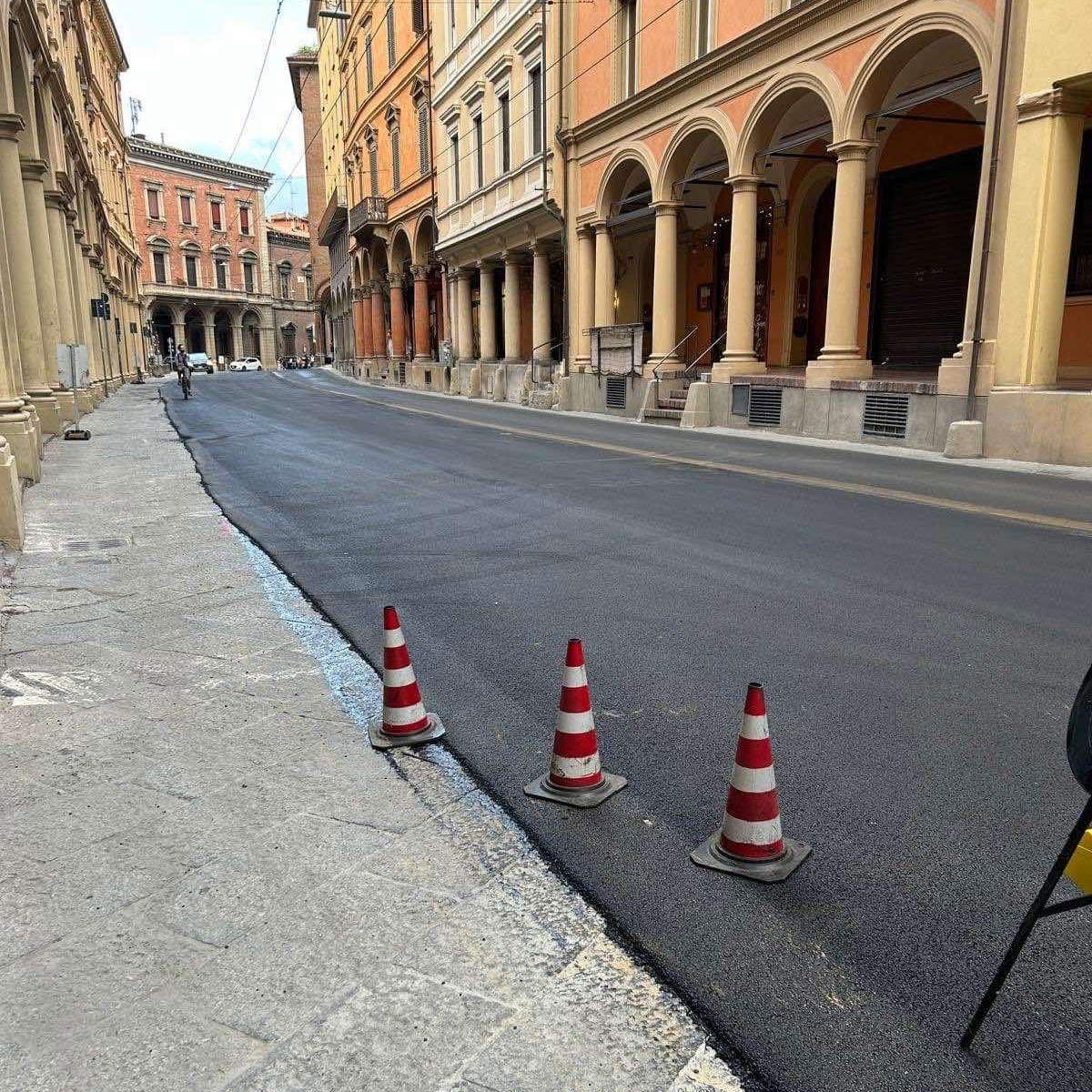Two central streets in Bologna, namely Via Farini and Via Santo Stefano, which are located in the heart of the Emilia capital, have been asphalted . In both streets, however, asphalt is nothing new: Via Farini and Via Santo Stefano, flanked on both sides by a long sequence of porticoes, are in fact among the main busy arteries of the historic center. Paved initially with large paving stones (and in some sections with cobblestones), over time they have been subjected to the pressure of transport vehicles and thus until recently were in less than optimal condition, and large patches of asphalt could be seen covering the most suffering areas. The section affected by the work (Via Santo Stefano is in fact a continuation of Via Farini) is the one between Piazza Minghetti and Via Guerrazzi. Therefore, the pedestrian section of Via Santo Stefano, the one from the two towers to the basilica, will not be touched.
The intervention on the two streets is a consequence of the problems suffered by the Garisenda tower: after the City Council detected anomalous oscillations in the city’s symbolic tower last fall that seriously jeopardized its safety, the Garisenda area was transennaded to get safety work started, and the traffic that normally flows around the tower was diverted in part to Via Farini and Via Santo Stefano, thus exacerbating the sealing problems of the two arteries.
Immediate protests were made by merchants and citizens over the result: two streets that were previously paved with elegant cobblestones now find themselves covered with asphalt. Of course, some say the two streets are now less dangerous for those who travel them by motorcycle or car (before they were full of potholes and consequent patching), but the aesthetic impact has raised the concerns of quite a few Bolognese. The Committee for Historic and Artistic Bologna, a long-standing association active since 1899, speaks of a leap back in time: “The very recent and deadly asphalting of the streets,” the committee writes in a note, “is, in some ways, an urbanistic ’time machine.’ it takes us back many decades, to when the center of Bologna was traversed by everyone (buses, trucks, cars), before the culture of preservation, which had created a semblance of urban quality, was completely abandoned.”
“We can rename Via Farini,” the BSA Committee adds ironically, “to ’Via dell’asfalto (formerly Via Farini),’ as was done in ancient times with place names commemorating inauspicious city events, or ’Via August 27, 2024’ to commemorate yet another lost battle to protect the city. The ugliness and coarseness of the intervention is alarming. It is the latest episode in a trend of heavy intervention in everything (buildings, greenery, streets, squares, etc.) with a general deterioration that is about to become irreversible. Noting that it was impossible to repair the pavements destroyed by the passage of buses, the solution of asphalting everything was adopted. The purpose is, in all evidence, to create alternative ’tracks’ to the roads closed for construction sites, where buses will be able to run freely. But not only that: by eliminating the paving stones, ongoing maintenance of the roads will disappear (a few shovelfuls of tar will suffice). Savings on maintenance is probably one of the reasons for general bitumizing. The next step will be the asphalting of Via Rizzoli and adjacent streets to accommodate even the public transportation moloch that, let us remember, has already disrupted the Garisenda (although everyone was quick to deny it). After looking at the archaic asphalt, we invite readers to search online for sites that continue to magnify Bologna as a sustainable city, regenerated, etc., and full of plans for a bright future.”
For the Municipality of Bologna, however, this is a temporary intervention in order to “allow the safe passage of public and private transport on a road axis that today is particularly busy due to detours caused by the Garisenda construction site,” as Palazzo d’Accursio made known in a meager note posted on Facebook. The point, however, is that at the moment there are no plans to repave the road with paving stones: “At this time,” the municipality explains, “it is not possible to resurface the road with paving stones, because it would be necessary to close for a long time a road that is fundamental for the city’s road system.” The final intervention, the statement concludes, there will be “only after the completion of the streetcar construction sites and the reopening of Via San Vitale.”
The response, however, did not satisfy citizens: in fact, it is not clear whether the final intervention will be done with paving stones or again with asphalt, and whether any changes to the downtown traffic plan are planned (in fact, one user suggests banning the large buses that run every day between the two streets, and instead adopting a different type of public mobility, which favors smaller and less heavy vehicles). In any case, in comments, the City Council made it known that there are currently no predictions on the timing of the final intervention.
Photo: Committee for Historic and Artistic Bologna
 |
| Bologna, central Via Farini and Via Santo Stefano paved. Citizens protest |
Warning: the translation into English of the original Italian article was created using automatic tools. We undertake to review all articles, but we do not guarantee the total absence of inaccuracies in the translation due to the program. You can find the original by clicking on the ITA button. If you find any mistake,please contact us.